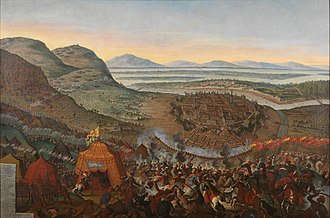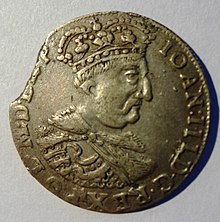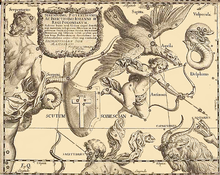Johann III. Sobieski
Johann III. Sobieski ( Polish Jan III Sobieski , Lithuanian Jonas Sobieskis ; born August 17, 1629 in Olesko , today Lviv Oblast , Ukraine ; † June 17, 1696 in Wilanów ) was a Polish aristocrat , statesman , grand hetman and from 1674 as King of Poland and Grand Duke of Lithuania the elected ruler of the state of Poland-Lithuania from the noble family of the Sobieskis . He is considered to be the savior of Vienna during the Second Turkish Siege of Vienna , as he led the decisive attack against the Turks with his Hussaria as Commander-in-Chief of the Catholic League at the Battle of Kahlenberg on September 12, 1683 .
Origin and youth

Johann (Jan) came from the Polish noble family of the Sobieskis, which belonged to the Janina coat of arms . He was the son of the Castellan of Krakow Jakub Sobieski and the Sofia Teofila out of the house Daniłowicz, and through them he was a great-grandson of Stanisław Żółkiewski .
In his childhood he received a thorough education at Poland's oldest school, the Nowodworski Collegium in Krakow. From 1640 to 1647 he studied at the Jagiellonian University , the then Studium Generale.
Travel and first war missions
From 1646 and 1648 he went on a grand tour through several European countries with his brother Marek . Jan's stay in France left lasting impressions . Between 1648 and 1653 he fought during the Khmelnytskyi uprising against the Zaporozhian Cossacks of Bohdan Khmelnytskyi and against Tatar troops of the Crimean Khanate . He fought in the Battle of Berestetschko before being sent as ambassador to the Ottoman Empire by King John II Casimir in 1654 . There he got to know the Turkish language and culture. His strategic talent was also evident early on.
In the Second Northern War 1655-1660 he first joined the faction of Krzysztof Opaliński , went in opposition to King John II Casimir and submitted to the Swedish King Karl X. Gustav . However, when the Swedish warfare increasingly took the form of a brutal raid, he moved again to the royal camp and fought in 1656 in the lost battle of Warsaw for John II Casimir, in which he distinguished himself and was promoted to royal standard bearer .
Promotion to the Grand Hetman
In 1655 he met his future wife (⚭ 1665) Marie Casimire Louise de la Grange d'Arquien ("Marysieńka"), a lady-in-waiting of the French-born Polish Queen Ludwika Maria . For Marie, who came from an old but impoverished family, her marriage to the son of one of the richest and most powerful families in Poland meant a tremendous rise. For Sobieski, the marriage intensified relations with the French aristocracy .
During the Russo-Polish War (1654–1667) he supported the king in the fight against the Lubomirski rebellion (1665–1666). After the death of Stefan Czarniecki he became field hetman for the Polish crown . In the Battle of Podhajce , during the Tatar-Cossack-Polish War 1666–1671 , he defeated a united Crimean Tatar -Cossack army under Hetman Petro Doroshenko as Polish commander in 1667 . In 1668 he became Grand Hetman of the Polish Crown and thus General Commander of the Polish Royal Army, directly subordinate to the King.
War against the Ottoman Empire and election as king
In the Ottoman-Polish War 1672–1676 , the Ottoman Empire conquered the Polish Podolia with the main festival Kamieniec Podolski . This conquest was recognized by King Michael I's emissaries in the preliminary peace of Butschatsch in 1672. With the Polish Reichstag not ratifying the treaty , the war continued for the next year. Sobieski placed the Turkish army of Grand Vizier Köprülü Fazıl Ahmed at the fortress of Chotyn and destroyed them on November 11, 1673 by a surprise attack by the Hussaria .
On 21 May 1674 he was after the death of King Michael I on the Polish throne elected . His pro-French attitude and the alliances with the French royal court spun by his wife also helped him to obtain the royal crown.
After eventful battles against the Ottoman Empire, he concluded the favorable Treaty of Żurawno in 1676 .
Anti-Brandenburg policy
In the first few years of his reign, Jan Sobieski tried to implement important reforms to consolidate the royal power against the nobility. He also sought an alliance with France against Brandenburg-Prussia . He tried to win back the Duchy of Prussia , which was a Polish fiefdom until the Treaty of Oliva (1660) , and to consolidate the power of Poland-Lithuania in the Baltic States . Due to the negative attitude of France after the unfavorable war between Sweden and the Elector Friedrich Wilhelm , he was forced to change his policy and to approach the emperor.
Alliance with Austria
In response to the Ottoman war preparations and at the urging of Pope Innocent XI. went Johann III. on April 1, 1683, a defensive alliance with Emperor Leopold I a. As soon as the news of the Turkish campaign in the direction of Vienna reached him, the king issued the general aristocracy and set out to liberate the threatened imperial capital.

Relief of besieged Vienna
On September 4, 1683, he held a council of war together with Charles V, Duke of Lorraine in Hardeggschen Schloss Juliusburg in Stetteldorf am Wagram . On September 7, 1683, the army of the Holy Roman Empire under Charles of Lorraine was united with the Polish troops in Tulln (approx. 30 kilometers from Vienna) and the troops marched together towards Vienna, which had been besieged by the Ottomans since July 15 . In the Battle of Kahlenberg , Jan Sobieski defeated the Ottoman army under Grand Vizier Kara Mustafa on September 12, 1683 as the commander of around 27,000 royal Polish, 19,000 imperial , 10,500 Bavarian , 9,000 Saxon and 9,500 south-west German soldiers . This ended the Turkish advance into the empire. Sobieski, as the official chief commander in chief of the united relief army , entered Vienna as a liberator of the Turks to the cheering of the population .
In the battle of Párkány he won again against the Turks together with Charles of Lorraine. In the Great Turkish War that followed, Habsburg was able to wrest the Kingdom of Hungary from the Ottomans .
Inheritance and death
King Jan III Sobieski was literary and linguistically gifted and worked as an art collector and patron . His royal palace in Wilanów near Warsaw is considered an outstanding example of the Polish Baroque . The family had another residence in the castle of Schowkwa . His “Letters to the Queen” went down in Polish literary history, and he wrote them to his wife almost every day of his numerous campaigns. There Sobieski shows himself to be a warm-hearted and literarily gifted private man.
He died in the royal residence in Wilanów in 1696 and was buried in the Wawel Castle in Kraków . In the elective monarchy of Poland, his son Jakob Louis Heinrich Sobieski was not heir to the throne, but the Elector of Saxony Augustus the Strong . His daughter Therese Kunigunde Sobieska was married to the elector Maximilian II. Emanuel von Bayern , his granddaughter Maria Clementina Sobieska was the wife of James Francis Edward Stuart , the titular king of Scotland, England, Ireland and France.
Relation to the present
- The constellation Schild was originally called Scutum Sobiescii (Shield of Sobieski) in honor of the king .
- Johann III. Sobieski is still one of the most popular rulers in Poland; His achievements as a general and patron as well as the legend of his happy family life contributed to his legend, the testimony of which his "Letters to the Queen" remain. Numerous streets and schools in Poland were named after him. Some companies are also trying to draw on its popularity and use the name of the king to upgrade their own brands , such as the Jan III Sobieski cigarette brand or Sobieski Vodka .
- The American actress Leelee Sobieski comes from a branch of the family. Direct descendants of the king have died out.
- In 1862 the Sobieskigasse and the Sobieskiplatz in Vienna- Alsergrund (9th district) were named after him.
- The portrait of Johann III. Sobieski has graced the front of the newly introduced 500 zloty banknote since 2017 .
- Since 1965 there has been an equestrian statue of Sobieski, created in 1898 by Tadeusz Barącz (1849–1905) for Lemberg in Gdansk . The residents , who were expelled from the Soviet Union after 1945 , had been allowed to take it with them.
Butcher
Battles fought by the Poles under the direct leadership of Johann Sobieski:
Parentage and offspring
|
Marek Sobieski * 1549/50 † 1605 |
Jadwiga Snopkowska * 1556/59 † 1588/89 |
Jan Daniłowicz * 1570 † 1628 |
Zofia Żółkiewska * ok. 1590 † 1634 |
||||||||||
|
Jakub Sobieski * 1580 † June 12, 1646 |
Zofia Teofila Daniłowicz * 1607 † 1661 |
||||||||||||
|
Maria Kazimiera d'Arquien * June 28, 1641 † January 17, 1716 ⚭ July 5, 1665 |
Jan III Sobieski * August 17, 1629 † June 17, 1696 |
||||||||
|
Jakub Ludwik Sobieski * November 2, 1667 † December 19, 1737 |
Daughter Sobieska * May 9, 1669 † May 9, 1669 |
Daughter Sobieska * May 9, 1669 † May 9, 1669 |
Teresa Teofila Sobieska * May 1670 † May 1670 |
Barbelune Sobieski * October 15, 1672 † 1677 |
|||||
|
Maria Teresa Sobieska * 1673 † 1675 |
Teresa Kunigunde Sobieska * March 4, 1676 † March 10, 1730 |
Alexander Benedikt Sobieski * 6./9. September 1677 † 16./19. November 1714 |
Konstanty Władysław Sobieski * May 1, 1680 † February 28, 1726 |
Daughter Sobieska * 1694 † 1694 |
|||||
See also

bibliography
literature
- Gerda Hagenau: Jan Sobieski. The savior of Vienna. Amalthea, Vienna 1983, ISBN 3-85002-158-0 (paperback edition: Ullstein, Frankfurt am Main and Berlin 1991, ISBN 3-548-22400-8 ).
- Stella Rollig, Paweł Jaskanis (Ed.): Jan III. Sobieski. A Polish king in Vienna. Hirmer, Munich 2017, ISBN 978-3-7774-2924-3 .
- Zbigniew Wójcik: Jan Sobieski. 1629-1696. Warsaw 1994.
- Joachim Zeller (Ed.): Jan Sobieski - Letters to the Queen. 2nd Edition. Suhrkamp, Frankfurt am Main 1986, ISBN 3-518-04525-3 .
- Hans-Joachim Böttcher : The Turkish Wars in the Mirror of Saxon Biographies , Gabriele Schäfer Verlag Herne 2019, ISBN 978-3-944487-63-2 , pp. 80–82, 97–102 u. a.
Web links
- Publications by and about Johann III. Sobieski in the VD 17 .
- Literature by and about Johann III. Sobieski in the catalog of the German National Library
- Works by and about Johann III. Sobieski in the German Digital Library
- Entry to Johann III. Sobieski in the Austria Forum (in the AEIOU Austria Lexicon )
- Ralf G. Jahn: Jan III. Sobieski Pedigree Report. In: adel-genealogie.de. November 13, 2002 .
- Hans Biedert, Tadeusz Kotlowski: Examples from history: Jan III. Sobieski (1629–1696) and the liberation of Vienna. In: Poland in Europe. State Center for Civic Education Baden-Württemberg , 1998, archived from the original on December 16, 2005 .
Individual evidence
- ↑ a b Jörg K. Hoensch: History of Poland . 3. Edition. Eugen Ulmer, Stuttgart 1998, ISBN 3-8001-2723-7 , pp. 153 .
- ^ Dietrich Schröder: Poland introduces 500 zloty notes. In: Märkische Oderzeitung (MOZ). February 8, 2017, accessed January 2, 2018 .
- ↑ Anna Ziemlewska: Gdansk, Sobieski Monument. In: Turkish memory. Austrian Academy of Sciences , accessed on January 15, 2020 .
| predecessor | Office | successor |
|---|---|---|
| Michael Wiśniowiecki |
King of Poland, Grand Duke of Lithuania 1674–1696 |
August II. Wettin |
| personal data | |
|---|---|
| SURNAME | Johann III. Sobieski |
| ALTERNATIVE NAMES | Jan III Sobieski; Jan Sobieski; Jonas Sobieskis |
| BRIEF DESCRIPTION | King of Poland and Grand Duke of Lithuania |
| DATE OF BIRTH | 17th August 1629 |
| PLACE OF BIRTH | Olesko |
| DATE OF DEATH | June 17, 1696 |
| Place of death | Wilanów |





